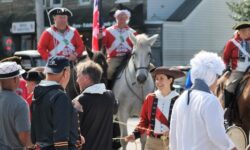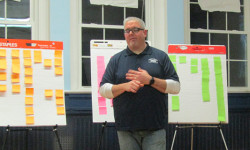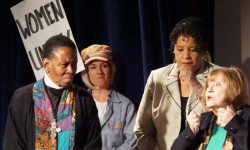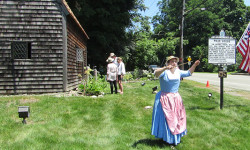[ccfic caption-text format="plaintext"]
By Bill Lombardi
Hometown Weekly Correspondent
In October of 1929, the stock market crashed. Millionaires became penniless overnight as the Great Depression began. In the absence of welfare programs, poverty ran rampant. It was in this context that local eyes began turning to a cemetery in Malden.
In late October, 1929 it was rumored that miracle cures of the sick and lame were happening at the gravesite of Father Patrick J. Power, a Catholic priest who had died 60 years before, in Malden, MA. The local media picked it up and the crowds grew larger every day. On November 4, six-year-old James Panora of Revere, MA, a deaf mute since childhood, was brought to the grave by his mother. After praying, they stood up. When his mother spoke his named, he answered, "What?" She then asked him to say “Father Power,” and he repeated the words. Mrs. Panora became hysterical with joy, and several hundred people dropped to their knees in thanksgiving.
The following day, nine-year-old Vincent O'Neill of Somerville, who lost his eyesight through an illness, was brought to the cemetery by his grandmother. After praying at the grave, they went to the small nearby cemetery chapel. Within a few minutes, he cried out: "Grandma, I can see tall white people!” He was staring at the statues in the chapel.
In the first week, ten people afflicted with various diseases claimed cures. Someone who had a vision problem an their eyeglasses with a note attached saying: “Cured, thank you Father Power.”
More and more automobiles appeared at the Holy Cross cemetery. Trolley cars were jam-packed. Rope barriers had to be installed to keep the crowd in order. After kneeling and praying at the gravesite, they would go to the chapel and continue meditating. The ground began to erode as worshippers scooped up handfuls of precious dirt. They touched and kissed Father Power’s headstone. They stood in the rain and knelt in the mud.
Six-year-old William Graul of South Boston was brought to Boston City Hospital in a dying condition. After a coughing spell, his throat was so contracted that a rubber tube was inserted to help his breathing. The boy’s parents went to the cemetery and stood in line for two hours. When his mother finally reached the tomb, she dipped her handkerchief into a chalice, in which water had accumulated from a recent rainstorm. They rushed back to the hospital and she applied the handkerchief to her son's throat. At first, the nurse ordered her to stop. When she explained it had been dipped in the water at the shrine, however, the nurse let her proceed. Later that day, the doctor came in to check the tube and discovered the boy could now breathe on his own.
The events began to appear in the national newspapers. On Sunday, November 17, over 200,000 people flocked to the cemetery. More trolleys had to be added and hundreds of cars were parked all around the cemetery. Many had out-of-state license plates from Arizona, Florida, Colorado, and even as far away as California. Residents living nearby offered lodging for a fee. Outside the cemetery were hot dog and souvenir vendors. The Malden police had a difficult time keeping the overwhelming crowd in order, and asked for assistance from police departments in the surrounding towns.
The physically handicapped and mentally ill pleaded to reach the grave of Father Power. Families became separated from each other. Jack Sharkey, the heavyweight boxing champ, stood in line to pray for his three-year-old daughter, Dorothy, who was boar blind in one eye. Boston Mayor-elect James Michael Curley knelt in the drizzling rain with his wife to pray for her failing health. A woman from New York, who had claimed her right hand had been paralyzed for years, began writing the words Father Power for the crowd. People from all over requested that some of the earth be sent to them, which cemetery officials refused to do.
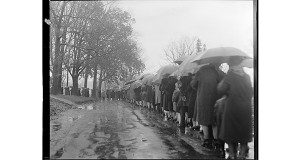
Thousands stand in the pouring rain, waiting to be cured at the grave of Father Patrick Power. Photos courtesy of the Boston Public Library, Leslie Jones Collection
Cardinal William O’Connell made his second appearance to the cemetery. He refused to make any comment on the activities that were happening and declined to acknowledge that miracles had taken place. Vigil candles glowed throughout the night as thousands stayed to pray.
A man on crutches, who claimed he was from Pennsylvania and had been crippled for years, discarded them after praying. He kept yelling with joy that he was cured and could walk again. He told the crowd gathered around him that he needed money to get back home. Holding his hat out, they began to toss in coins. Suspicious, police noticed his bandage and crutches were brand new. They took him aside and after careful questioning, were convinced that he was a fraud. The police threatened to arrest him as a vagrant if he didn’t leave the cemetery.
There were other cases in which people claimed cures, but witnesses who knew them verified that they never had any afflictions. Now it was becoming a circus. People were discarding their crutches. The paralyzed could walk, the deaf could hear, the mute could speak, and the blind could see. Many cars were reported stolen and also wallets, pocketbooks and purses.
On November 24, Cardinal O’Connell ordered the cemetery closed and the gates were locked. Only those in funeral processions were permitted inside. Father Power’s body was exhumed and moved to another site. A high, six-foot iron fence was erected to protect the grave from being disturbed. No one was allowed to stop at his grave.
People traveling from all parts of the United States were unaware that they would not be allowed to enter the cemetery. When they arrived, they found policemen stationed at every entrance. Heartbroken and disappointed, they knelt on the sidewalk facing the grave only 300 yards away and prayed. As time passed, people lost interest and the gates were reopened. From November 3 to November 24, it was estimated that a million people had visited Father Power’s grave.
After researching the story, I wanted to find out if there were any actual cures. It’s been a long time, but I was still able to locate a few distant relatives. One refused to talk to me, and another refused to reveal if there was an actual cure. I did talk to the sister of James Panora, the deaf mute who spoke Father Power’s name. She informed me that though she hadn’t been born at the time, as far as she could remember, her brother was always able to mumble a word or two.
It has been almost 90 years, and people continue to visit Father Power’s grave. It is protected by the fence and visitors toss coins onto the grave, making it not only a shrine but a wishing well.
Whether there were any actual cures is unknown. What is more important is that this extraordinary religious event had brought a million health-seekers together in prayer and hope.
Father Patrick J. Power was born in Bantry, County Cork, Ireland, on October 20, 1844. he came to the United States and studied for the priesthood at St. Joseph’s seminary in Troy, NY. He was ordained at the Holy Cross Cathedral in Boston and served at the Holy Redeemer Church in East Boston. He loved to walk in the rain and it is believed that while recovering from an illness, he contacted pneumonia during one of his walks. On December 8, 1869, the Feast of the Immaculate Conception, he died at his brother’s house in the Fairmount Hill section of Brookline. He was only 25 years old.
Bill Lombardi is a U.S. Marine Corps veteran. He is the grandfather of Emily, Ashley and Zachary Sullivan, and Cayce and Jimmy Lombardi - all Walpole residents.
The Leslie Jones Collection is accessible online at www.digitalcommonwealth.org, which provides access to photographs, manuscripts, books, audio recordings, and other materials of historical interest that have been digitized and made available by members of Digital Commonwealth, a statewide consortium of libraries, museums, archives, and historical societies from across Massachusetts.






